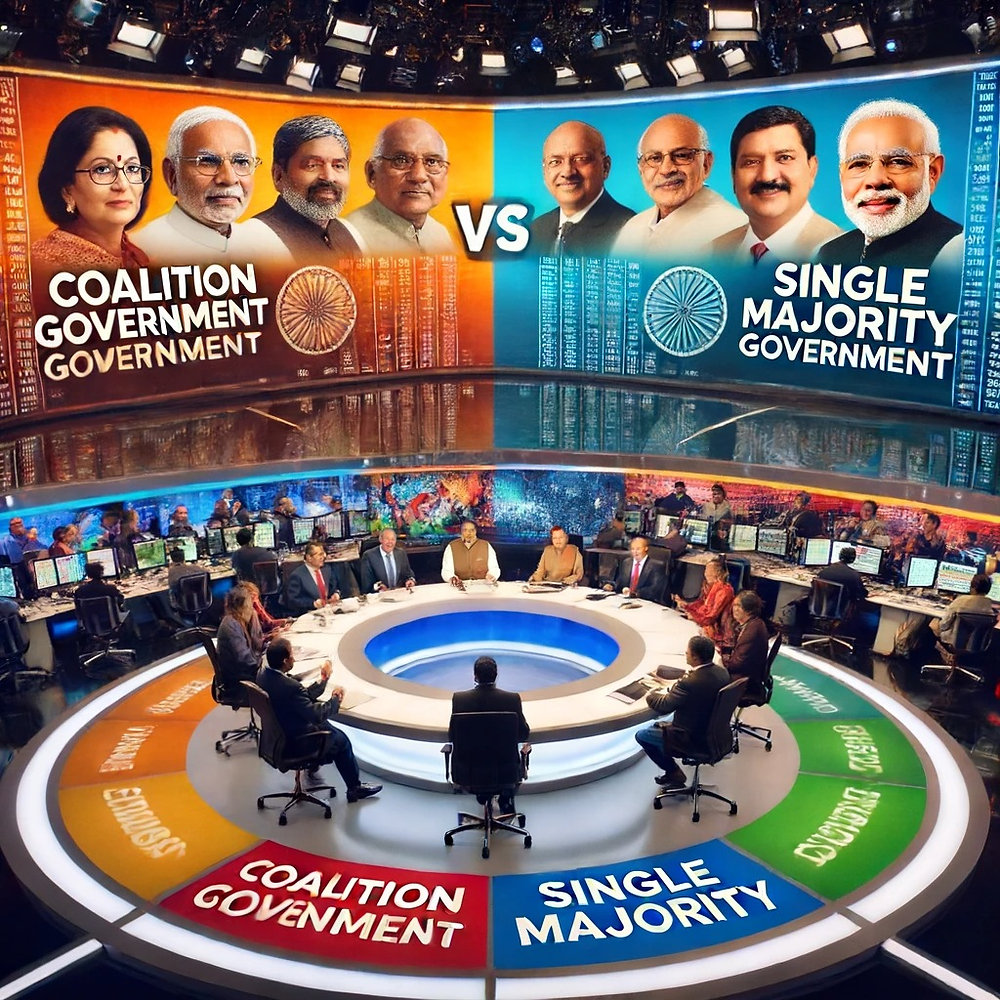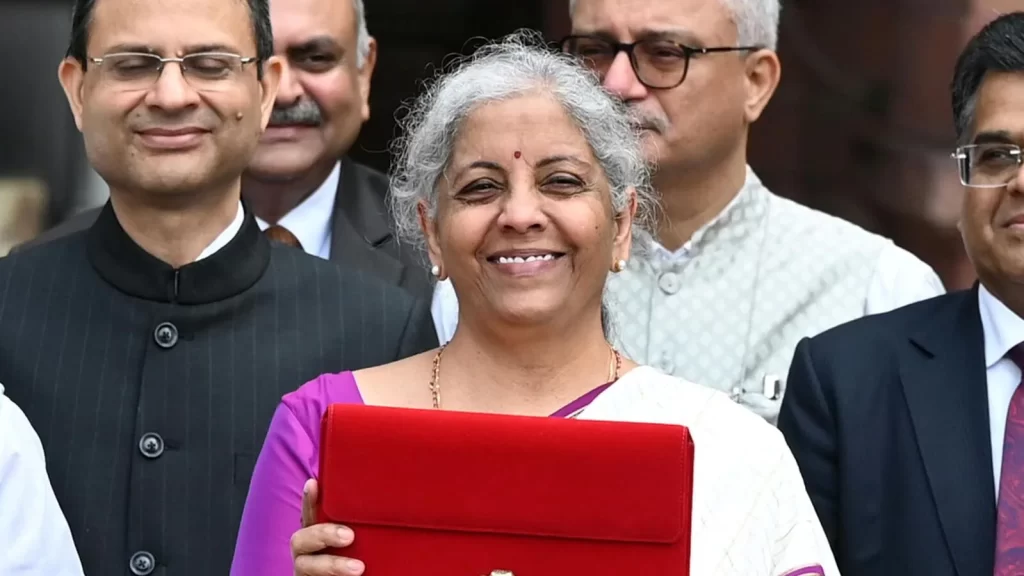The public choice theory literature shows that the lobbying by the various interest groups with the ruling party’s wish for remaining in power results in the policy distortions exchanged for electoral support. The coalition governments have not been unstable given the example of the Left Front Government in India. In 2010 book “Coalition Politics and Economic Development : Credibility and the Strength of the Weak Governments’ ‘, economist Ifran Nooruddin contested the conventional ideas that the coalition governments obstruct the necessary policy reform in the developing nations. He argued that the coalition governments by institutionalising the deadlock actually leads to the promotion of the economic growth through stabilisation of the investor expectations and lowering of the unpredictability and uncertainty of policies. The fact that the process of India’s economic liberalisation began under the coalition governments also demonstrates the fact that coalition governments slow down the economic reform agenda. This is one of the fundamental dilemmas of the political economy of India. The article aims to unravel this dilemma through the Indian experience.

The Indian Experience
The Indian case is an interesting one in this regard as there is no correlation between the coalition government and the GDP growth. For example, the Congress-led United Progressive Alliance (UPA) government has seen an average of 6.8% GDP growth in India during 2004-14. The economy had been growing at a rate of 6.9% during the first five years of the UPA-I. However, during the UPA-II government of 2009-14 it was 6.7% despite the fact that Congress had gained 206 seats in the Lok Sabha. There has been a general consensus for reforms, the parties of the ruling coalition have come to decide the exact nature of the economic reforms.
Looking back at India’s economic history, it has become definite that the coalition governments have taken some of the boldest and visionary reforms. The country’s economic history since 1991 has shown that coalition governments have been successful at reform and the economy also delivers high growth. These reforms have also been one of India’s most stable and enduring policies that is pursued vigorously today and the balance for India’s resurgence. In terms of economic governance, an aspect that distinguished the past two Lok Sabhas was that it was the first time since the beginning of the economic reforms (1991) that a single party- Bharatiya Janata Party (BJP) enjoyed a majority mandate. This was expected to have a salutary effect on the economic reforms trajectory. Since 1991, the governments have been a coalition of sorts where the lead party was far from the 272 majority mark. This has been the obvious weakness of the leading party- whether the Congress or the BJP or the Third Front is in power- meant that India always had- borrow the words of Montek Singh Ahluwalia (former Deputy Chairman of the erstwhile Planning Commission)- “a strong census for weak reforms.” So,a coalition government is a strong consensus for weak reforms.
Some of the notable reforms brought by the previous coalition governments include the reforms brought in by the Narasimha Rao-led government such as under this minority government becoming a member of the World Trade Organisation (WTO). The short-lived Deve Gowda government has placed faith in the Indian taxpayers and cut tax rates. Under the Atal Bihari Vajpayee-led Government, the government successfully framed the Fiscal Responsibility and Budget Management (FRBM) Law and the Information Technology Act in 2000. Coalition governments meant the accomodation of the diverse interests as such as the UPA government (2004-2014) which included the DMK, NCP and RJD.
The 2024 Indian General Elections
Indian General Elections 2024 marks the triumphal return of a new coalition era in Indian Politics after a 10 year hiatus. The debate on the progress of the economic agenda under coalition governments has been raised recently in the current Indian political landscape. The fact that the single party governments derive the bold economic reforms is partially true. Over the past decade under PM Modi, Narendra Modi was supposed to sort out the weakness and provide weakness to the investors about the issue of policy stability and a push towards economic reforms. It led to the introduction of bold economic reforms such as the GST and the creation of the Insolvency and Bankruptcy Code, however, the government has failed to bring in land acquisition. The failure of the farm reforms has to be particularly noticed during the Modi Government.
Post the General Elections 2024, the BJP is dependent on the support of the regional allies, namely the Telugu Desam Party and Janata Dal (United). So far, the pivotal allies of the NDA government have largely laid low in their demands from the BJP. The TDP has been assigned the old mainstay for the allies i.e, the Ministry of Civil Aviation. The ministries granted to the allies include the Ministry for Panchayati Raj, Fisheries and Animal Husbandry, Steel and Heavy Industry, Food Processing for Small and Medium Enterprises, Skill Development and Traditional Healthcare Systems. Though the Skill Development and Entrepreneurship Ministry has been allocated to Rashtriya Lok Dal’s head, this is certainly a major driver for policy making. The Telugu Desam Party (TDP) having 16 seats in the Parliament, led by Chandrababu Naidu, is also seeking special status for the state of Andhra Pradesh and granting more funds to the state. The key portfolios such as defence, finance, home affairs, external affairs, indeed transport, highways and railways have been kept by the BJP. There have been a series of coalition governments including the AB Vajpayee led NDA and two terms of the UPA government and in several of these tenures, there has been deepening and strengthening of the 1991 liberalisation reforms. The Janata Dal led by Nitish Kumar have also long demanded a great infusion of federal funds into their state’s coffers and a review of the Agniveer Scheme. India’s indirect tax regime increased the efficiency however it led to the reduced policy levers to the state leaders. The RJD leader has also said that the new National Democratic alliance (NDA) government at the centre has accorded special status to Bihar and also brought about the opposition’s demand for a nationwide caste census. The Congress and the regional parties have alleged that the BJP has been dragging its feet on the issue of caste census. However, recently, the BJP Union Minister has stated that the BJP has not opposed the caste census however it would require careful consideration. This is a significant change given BJP’s initial stance on the issue. It has softened its stance on the issue and is even considering it in many states.

Naidu’s TDP has also built his party’s reputation on competent administration, and is perceived as a forward-looking party with regard to economic reform and growth. WIth the return of Naidu in the national politics, the much debated and long-pending demand of Special Category Status (SCS) to Andhra Pradesh is back in the limelight. The implementation of the SCS status will also pave the way for the development of the capital city and bring the finances in a better shape. He is also expected to receive support from the Modi 3.0 Administration for the revival of Amravati and the long-pending Polavaram project. These demands are regional in nature, which is characteristic of a coalition government. The NDA government in power is required to tread the regional demands carefully.
The broader direction of the economy is unlikely to change. Lekha S. Chakraborty, economist and Professor at the National Institute of Public Finance and Policy argued that there will be continuation of the policies with regard to public infrastructure and investment which would certainly boost economic growth. She also added that the continuity of the economic reforms with regard to the labour codes and taxation policies, these policies will face more roadblocks and more deliberations. The privatisation and the asset monetization issues are at risk which could drag the government capex in the short run. The implementation of the big-bang reforms such as the farm bills, Uniform Civil Code, One Nation, One Election and land reforms would be challenging. Some analysts had pointed out that a weakened mandate for the National Democratic Alliance (NDA) could make it impossible for the government to pass legislation on the more ambitious parts of the government’s economic reform agenda. India should be able to deliver a growth rate of 6-7% in FY25. The reform trajectory will become more broader and inclusive in nature. The current government is likely to be successful in continuing its investment-led economic growth agenda such as the ease of doing business and digitalisation, however the reforms related to agriculture, land and labour could become more difficult.
The coalition government will also potentially herald an era of better fiscal federalism in the country and bringing in proper frameworks for reducing the conflict between the State and the Central government. The tussle between the Centre and the State is also one of the most pressing issues in recent years. The coalition politics will always have competing ideologies, ideas and interests which would lead to policy bargains and policy compromises as well. India’s past experience with the coalition government has not been bad. There will be checks and balances which might improve governance. The coalitions over the period of time have institutionalised the policy making mechanisms which have been accommodating different voices. For example, the V.P Singh government had six committees for examining the most pressing issues of the times. This has continued albeit in different forms in successive governments of Atal Bihari Vajpayee and UPA era too. There would be greater dialogue in the policy making process.

Secondly, in a coalition government, the role of the state governments is higher. This has an impact on the evolving federalism in the country. In the last five years, the debate has sharpened on the state’s share in the divisible pool of taxes. When Narendra Modi first came into power, it had pledged to strengthen “cooperative federalism” and the government also accepted the 14th Finance Commission’s Report which aims to increase the state government’s share of the taxes. However, the recent trends over the last decade talk of a different story wherein the Niti Aayog has replaced the Planning Commission and also the political centralisation of the decision-making to the PM’s office. A source of tensions between the states and the central government has been GST wherein the result was the decline of revenue for the states and the states’ voices were not articulated properly in the policy making.
It is also a question whether there would be a radical change in the BJP’s decision-making and governance as all the important cabinet portfolios stay with the BJP. The economic outlook of the allies of the BJP in the government has differences with the BJP’s working style with regard to the distribution of power and the decision making. The current government would be required to make a degree of compromise and adjustment to its policy and regulatory framework for accommodating the interests of the coalition governments. There is also a prospect of increased focus on the regional industries under the ‘Make in India’ policy. It is also to be seen how the new government implements its renewable energy projects as businesses are also expecting increased regulatory scrutiny and more complex lengthy processes of large scale infrastructure and renewable energy projects. This can be perceived as a roadblock in the bold economic governance however this would led to more successful and stable policies.
The coalition government can potentially affect bringing in successful farm laws which had previously faced backlash due to the lack of a broader dialogue among the various stakeholders. The role of the state governments in the national coalitions is higher in nature, which reflects the need for inclusivity in the policy decision making. These inclusive decision making processes and increased transparency can facilitate sustained economic growth and reform. Coalition governments would also lead to the promotion of better Centre-State balance. It has also been observed that in recent years, states have accused the Central government of centralisation. The challenges of the different ideological leanings is not a feature of only the coalition governments as single party governments have also faced the challenge of the internal checks within the party, internal party differences and policy reversals, as in case of Rajiv Gandhi’s tenure.
It is also a possibility that the BJP government will require a more consultative and deliberative approach. However, as the leadership remains unchanged and with Modi’s return, this suggests continuity in policies and regulatory continuity for the foreseeable future. The coalition partners may as well advocate for the growth and development of regional industries. With regard to the approval of the large-scale implementation of the infrastructure and renewable energy projects. The economic outlook is broadly positive. To conclude, coalition governments do not necessarily slow down the economic reform agend
Written by Sourishree Ghosh
Edited by Khalid Khursheed Muzaffar.




